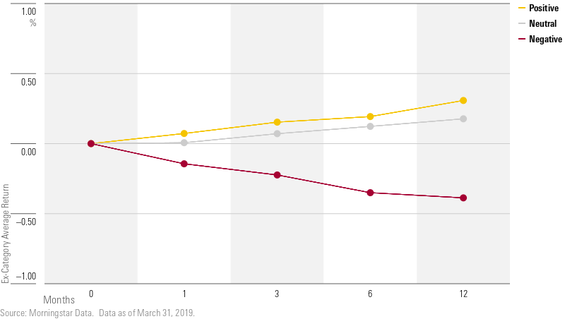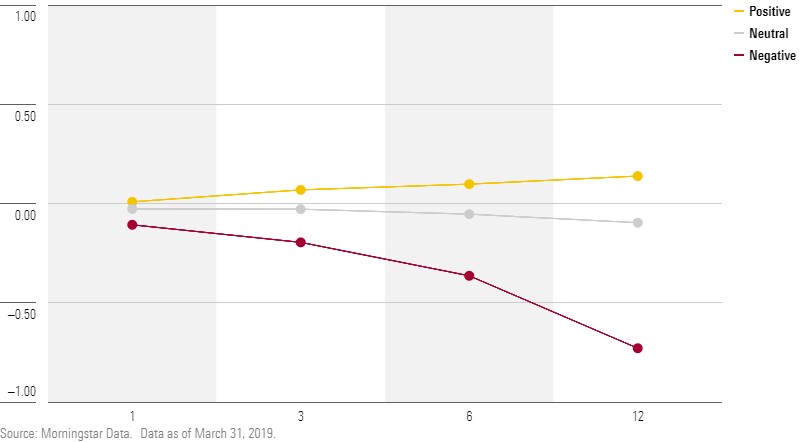Traditionally, ratings systems are evaluated from the perspective of choosing the best possible investment. However, avoiding poorly performing investments can be equally important in improving investor outcomes.
Often, investors do not choose investments from scratch; rather, they have already invested in certain funds and need to decide whether to switch out of their current fund selection. If the investor decides to switch, it may be unclear as to what constitutes a superior alternative.
With this perspective in mind, we take a new look at how the Morningstar Quantitative Rating for Funds can help answer the question.
Can the MQR help improve fund selection?
We conducted an event study to evaluate whether the MQR produced ratings that improved fund selection and helped choose funds that are superior to their peers. The analysis relied on grouping funds by their Morningstar Quantitative Rating, averaging their future performance, and looking at excess returns.
The chart below shows the returns of Positive, Neutral, and Negative ratings in excess of the average returns of each fund's Morningstar Category. Positive ratings included funds with Morningstar Medalist ratings of Bronze, Silver, and Gold.
The event study’s findings include:
- The Neutral rating outperforms the Negative rating, and the Positive ratings group outperforms both Negative and Neutral ratings.
- The average excess return of the Positive rating group is slightly positive, which suggests that funds positively rated by the MQR may outperform their peers.
- The biggest gap in performance is between the Negative and Neutral funds, which return 73 and 10 basis points below the category average, respectively, after 12 months. This means that it can be nearly as beneficial to switch from a Negative fund to a Neutral fund as it would be to switch from a Negative to a Positive fund.
How the MQR may impact fund selection for new funds
We conducted a similar event study focused specifically on funds that have existed for 12 months or fewer at the time of rating.
Like with the initial event study, the ratings groups sorted properly. As the chart below shows, the biggest gap in performance after 12 months was between the Negative and Neutral ratings, which returned 39 basis points below and 18 basis points above the category average, respectively. Negative funds do particularly poorly relative to their peers, so an investor could seek better outcomes by switching to a Neutral fund.

These observations can be particularly helpful for new funds, which may have little information to help advisors evaluate the fund.
How the MQR may impact fund selection for older funds
We also examined this data for funds that are a bit older (existing for 36 to 60 months). The chart below shows that this data set yielded a similar separation between the differently rated funds.
Though the MQR is still able to effectively distinguish the quality of new funds, it does a better job of separating funds with a longer track record because there is more data to leverage. This explains why the MQR can more confidently place poor funds in the Negative group, resulting in the Negative group underperforming by a wider margin than when newer funds are rated.
How financial advisors can use the MQR to optimize fund selection
These findings suggest that if an advisor is examining multiple investment options, the MQR can help steer them away from inferior funds. Advisors may consider:
- Switching from Negative-rated funds to Neutral-rated funds, where more feasible, over Positive-rated funds, as they can also yield tangible improvements in performance.
- Utilizing the MQR to help inform decision-making where there is less data available about funds, as tends to be the case for newer funds.
Our analyses show that the Morningstar Quantitative Rating for Funds is effective at separating funds based on how they perform after the rating. It also benefits advisors and investors by demonstrating which funds to avoid, rather than which funds to select.
To learn more about how the Morningstar Quantitative Rating differs from our analysts' analyses, check out this video.



